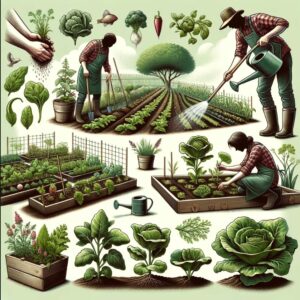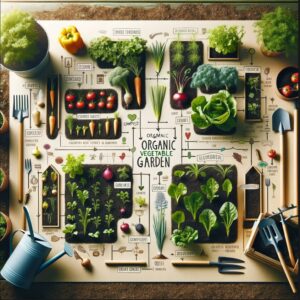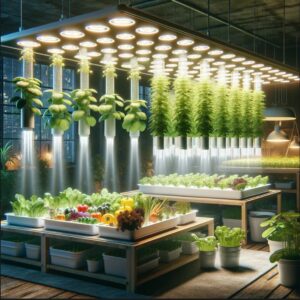Organic Vegetables: Step-by-Step Techniques for Thriving Gardens at Home
Organic Vegetables: Step-by-Step Techniques for Thriving Gardens at Home
In the quest for healthier living and sustainable practices, growing organic vegetables at home has gained considerable traction among gardening enthusiasts and eco-conscious individuals alike. Embracing organic gardening means nurturing your vegetables without relying on synthetic fertilizers or pesticides, fostering a natural environment that’s not only beneficial for your health but also kind to the planet. This guide, “Organic Vegetables: Step-by-Step Techniques for Thriving Gardens at Home,” is designed to walk you through the essentials of cultivating your organic vegetable garden, from the initial planning stages to the joyous moment of harvest.
Embarking on the journey of organic vegetable gardening offers a myriad of benefits, including access to fresh produce, the reduction of your carbon footprint, and the therapeutic joy of connecting with nature. Whether you have a spacious backyard or a modest balcony space, this guide will provide you with the knowledge and tools needed to start your organic gardening adventure. We’ll delve into the importance of choosing the right location, preparing the soil naturally, and selecting vegetable varieties that will thrive in your garden’s unique conditions. Additionally, we’ll explore innovative gardening techniques, such as utilizing LED grow lights for year-round cultivation and setting up a basic hydroponic system, to enhance your gardening experience.
By the end of this guide, you’ll be equipped with the step-by-step techniques essential for creating and maintaining a flourishing organic vegetable garden at home. So, let’s don our gardening gloves and embark on this green journey together, cultivating not just vegetables, but a lifestyle rooted in sustainability and well-being.

Understanding Organic Vegetable Gardening
Organic gardening goes beyond just avoiding synthetic chemicals; it’s about fostering an ecosystem that promotes natural growth and sustainability. At its core, organic vegetable gardening is about working in harmony with nature, creating a productive environment that benefits both the gardener and the ecosystem.
- The Principles of Organic Gardening: Organic gardening is grounded in the principle of nurturing plants in a way that maintains and enhances the soil’s natural health. It emphasizes the use of organic matter, such as compost, to enrich the soil, which in turn nourishes the plants. This approach ensures that the vegetables are grown in a toxin-free environment, yielding healthier and more flavorful produce.
- Benefits for Health and Environment: Growing vegetables organically eliminates the risk of consuming pesticide residues, offering a cleaner alternative for your diet. Moreover, this method reduces pollution and conserves water, contributing to a healthier environment. The absence of chemicals also encourages biodiversity, attracting beneficial insects and promoting a balanced ecosystem in your garden.
- Understanding Soil Health: Healthy soil is the foundation of a successful organic garden. Organic gardeners focus on building soil that is rich in organic matter and teeming with microbial life. This not only provides a robust environment for plants to thrive but also enhances the soil’s ability to retain water and nutrients, reducing the need for external inputs.
- Composting: One of the pillars of organic gardening is composting. This natural process recycles organic material into a rich soil amendment, providing a steady stream of nutrients for your plants. By composting kitchen scraps and yard waste, you not only enrich your soil but also reduce landfill waste, embodying the principles of sustainability and resourcefulness that are central to organic gardening.
- Choosing the Right Plants: Selecting the right plants is crucial in organic gardening. Opting for native or well-adapted plants can reduce the need for water and fertilizer and increase the garden’s resilience to pests and diseases. Understanding your climate, soil type, and local ecosystem can guide you in choosing plants that will thrive in your organic garden.
By embracing these principles, you’ll be well on your way to establishing a thriving organic vegetable garden at home. As you delve deeper into organic practices, you’ll discover the joys and rewards of growing your food in harmony with nature, reaping the benefits of your efforts in the form of fresh, nutritious produce right from your backyard.
Planning Your Organic Vegetable Garden
Embarking on your organic vegetable gardening journey requires thoughtful planning and a strategic approach. By carefully considering factors like location, soil, and plant selection, you can lay a solid foundation for a thriving garden. Here’s how to get started:
- Choosing the Right Location: The success of your garden starts with selecting the right spot. Most vegetables require at least 6-8 hours of direct sunlight per day. Observe your potential garden area throughout the day to identify the sunniest spots. Also, consider accessibility for watering and proximity to compost or tool storage for convenience.
- Soil Preparation: Organic gardening thrives on rich, fertile soil. Begin by testing your soil to understand its type and pH level, adjusting as necessary to meet the needs of your chosen vegetables. Enhance your soil with organic matter, such as compost or aged manure, to improve its structure, fertility, and water retention.
- Choosing Vegetables: Select vegetables that are suitable for your region’s climate and soil conditions. Consider starting with easy-to-grow options like lettuce, radishes, or tomatoes. Incorporate a mix of vegetables that you enjoy eating and that can be harvested at different times, ensuring a continuous supply throughout the growing season.
- Garden Layout: Plan your garden layout, keeping in mind the space requirements of each plant and their compatibility with each other. Utilize companion planting to naturally repel pests and enhance growth. Remember to provide adequate space between rows or plants for air circulation and ease of maintenance.
- Tools and Resources: Equip yourself with the necessary tools and resources for organic gardening. Basic tools include a spade, garden fork, hoe, and watering can. Consider investing in quality tools that will last and reduce unnecessary waste and consumption.
By meticulously planning your organic vegetable garden, you’re setting the stage for a rewarding and sustainable gardening experience. This preparation not only facilitates a smoother gardening process but also maximizes your garden’s productivity, ensuring a bountiful harvest of fresh, organic vegetables right from your home.

Innovative Growing Techniques: LED Grow Lights and Hydroponic Systems
In the realm of organic vegetable gardening, embracing innovative techniques can enhance your garden’s productivity and overcome common challenges. Two such advancements are LED grow lights and hydroponic systems, which offer unique benefits for indoor and small-space gardening.
- LED Grow Lights: LED grow lights have revolutionized indoor gardening by providing a reliable and energy-efficient light source. These lights emit a spectrum of light that mimics natural sunlight, essential for plant photosynthesis. They’re ideal for spaces lacking in natural light, allowing you to grow vegetables year-round, regardless of outdoor conditions. When selecting LED lights, consider factors like light intensity, spectrum, and coverage area to match your garden’s needs.
- Benefits of LED Grow Lights: Using LED lights can lead to faster plant growth, increased yields, and the ability to control the vegetative and flowering stages with specific light wavelengths. They’re also more energy-efficient and have a longer lifespan compared to traditional grow lights, making them a sustainable choice for the eco-conscious gardener.
- Hydroponic Systems: Hydroponics is a method of growing plants without soil, using a nutrient-rich water solution. This technique is perfect for organic gardeners with limited space, as it allows for higher density planting and can be set up indoors or in small outdoor areas. Hydroponic systems come in various types, such as deep water culture, ebb and flow, and nutrient film technique, each suitable for different plants and spaces.
- Benefits of Hydroponic Systems: Hydroponic gardening offers faster plant growth, efficient water usage, and reduced pest and disease risks. Since the plants receive nutrients directly from the water, they can allocate more energy to growth rather than developing extensive root systems to search for nutrients. Additionally, hydroponics allows for precise control over nutrient levels, pH, and other factors, leading to healthier and more productive plants.
- Combining LED Grow Lights with Hydroponics: Integrating LED grow lights with hydroponic systems can create an optimal environment for vegetable growth, especially in urban settings or during off-season periods. This combination maximizes space utilization and control over growing conditions, offering a sustainable and efficient way to produce organic vegetables year-round.
By incorporating these innovative techniques into your organic vegetable gardening practice, you can expand your gardening possibilities and enjoy fresh, home-grown vegetables regardless of space or seasonal limitations.

Planting and Maintaining Your Garden
Creating a thriving organic vegetable garden requires attentive planting and ongoing care. This section provides step-by-step guidance on planting your organic vegetables and maintaining your garden for optimal health and productivity.
- Planting Your Vegetables: Start by selecting high-quality, organic seeds or seedlings. When planting, consider the specific needs of each vegetable, such as spacing, depth, and orientation to the sun. Proper planting ensures your plants have the room they need to grow and receive adequate sunlight and air circulation.
- Watering Wisely: Regular and consistent watering is crucial for vegetable gardens, but overwatering can be just as harmful as under-watering. Use a watering can or drip irrigation system to deliver water directly to the base of the plants, reducing evaporation and minimizing leaf wetness that can lead to disease. Adjust your watering schedule based on rainfall, temperature, and the specific needs of your plants.
- Mulching: Applying organic mulch around your plants helps retain soil moisture, suppress weeds, and regulate soil temperature. Organic mulches, like straw or grass clippings, also break down over time, enriching the soil with organic matter.
- Monitoring Plant Health: Regularly inspect your plants for signs of stress, pests, or disease. Early detection is key to managing potential issues before they escalate. Healthy plants are better equipped to resist pests and diseases, so focus on providing optimal growing conditions.
- Succession Planting and Crop Rotation: To extend your harvest and maintain soil health, practice succession planting by staggering plantings of crops that mature quickly. Additionally, rotating crops each year can prevent soil depletion and reduce the buildup of pests and diseases associated with specific plant families.
By following these planting and maintenance tips, you’ll cultivate a garden that not only produces bountiful harvests but also contributes to the ecological balance of your outdoor space. Whether you’re a seasoned gardener or a green-thumbed novice, these practices will help ensure your organic vegetable garden is healthy, productive, and sustainable.

